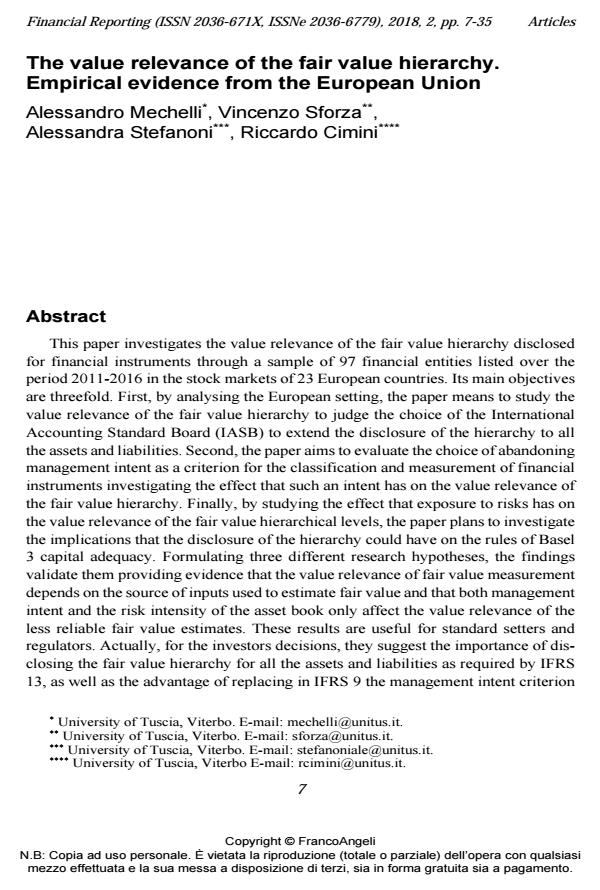The value relevance of the fair value hierarchy. Empirical evidence from the European Union
Journal title FINANCIAL REPORTING
Author/s Alessandro Mechelli, Vincenzo Sforza, Alessandra Stefanoni, Riccardo Cimini
Publishing Year 2018 Issue 2018/2
Language English Pages 29 P. 7-35 File size 539 KB
DOI 10.3280/FR2018-002002
DOI is like a bar code for intellectual property: to have more infomation
click here
Below, you can see the article first page
If you want to buy this article in PDF format, you can do it, following the instructions to buy download credits

FrancoAngeli is member of Publishers International Linking Association, Inc (PILA), a not-for-profit association which run the CrossRef service enabling links to and from online scholarly content.
This paper investigates the value relevance of the fair value hierarchy disclosed for financial instruments through a sample of 97 financial entities listed over the period 2011-2016 in the stock markets of 23 European countries. Its main objectives are threefold. First, by analysing the European setting, the paper means to study the value relevance of the fair value hierarchy to judge the choice of the International Accounting Standard Board (IASB) to extend the disclosure of the hierarchy to all the assets and liabilities. Second, the paper aims to evaluate the choice of abandoning management intent as a criterion for the classification and measurement of financial instruments investigating the effect that such an intent has on the value relevance of the fair value hierarchy. Finally, by studying the effect that exposure to risks has on the value relevance of the fair value hierarchical levels, the paper plans to investigate the implications that the disclosure of the hierarchy could have on the rules of Basel 3 capital adequacy. Formulating three different research hypotheses, the findings validate them providing evidence that the value relevance of fair value measurement depends on the source of inputs used to estimate fair value and that both management intent and the risk intensity of the asset book only affect the value relevance of the less reliable fair value estimates. These results are useful for standard setters and regulators. Actually, for the investors decisions, they suggest the importance of disclosing the fair value hierarchy for all the assets and liabilities as required by IFRS 13, as well as the advantage of replacing in IFRS 9 the management intent criterion with the business model test and the characteristics of the instruments for the classification and measurement of financial assets. For the future, the findings suggest the opportunity to introduce filters within the common equity tier 1 for the less reliable fair value estimates. This paper’s current and future implications for standard setters and regulators are to avoid earnings management and capital management behaviour possibly affecting the quality of financial reporting.
Keywords: Value relevance, fair value hierarchy, IFRS 13, financial entities
Jel codes: M41
- Non-Fungible Token valuation: State of the art and future insight Paola Paoloni, Giuseppe Modaffari, Martina Manzo, in FINANCIAL REPORTING 2/2023 pp.39
DOI: 10.3280/FR2023-002002
Alessandro Mechelli, Vincenzo Sforza, Alessandra Stefanoni, Riccardo Cimini, The value relevance of the fair value hierarchy. Empirical evidence from the European Union in "FINANCIAL REPORTING" 2/2018, pp 7-35, DOI: 10.3280/FR2018-002002